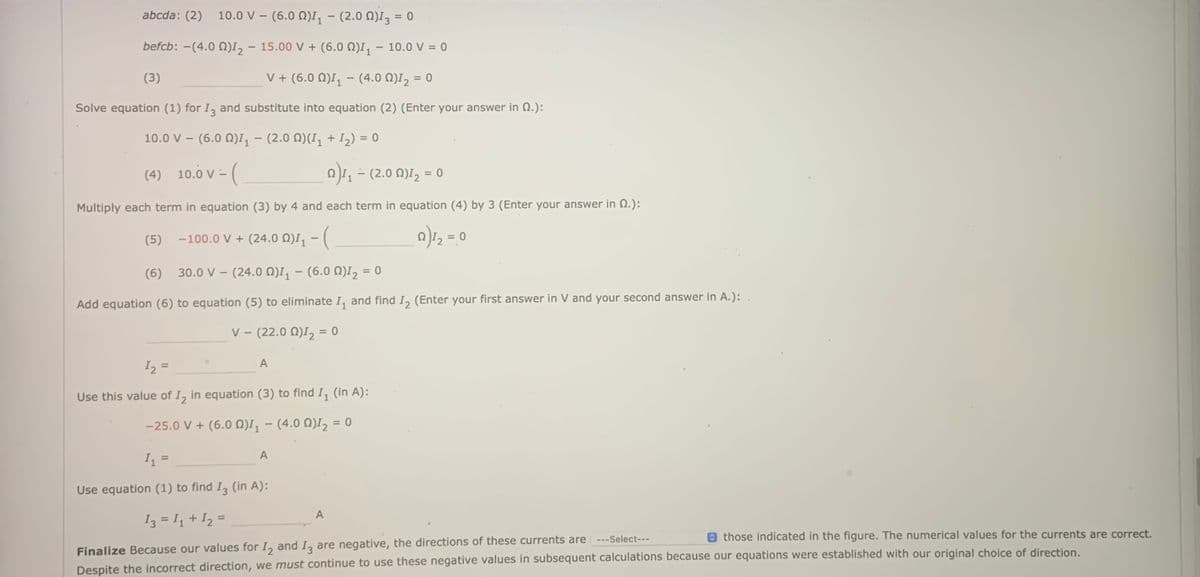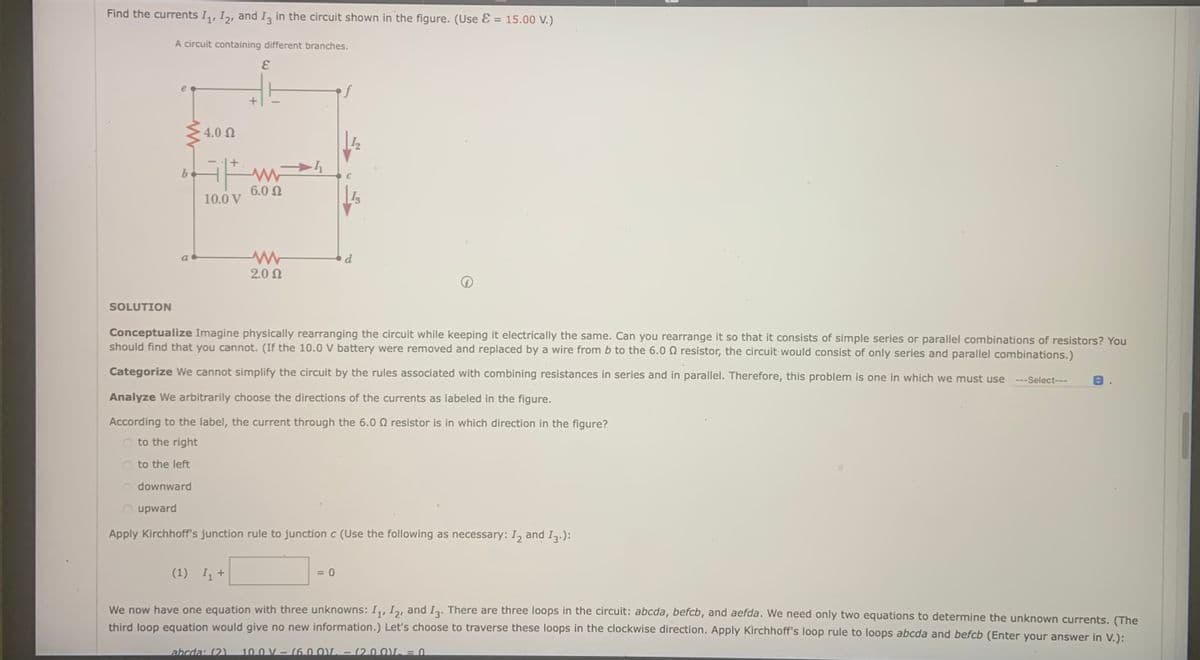abcda: (2) 10.0v - (6.0 0)/, - (2.0 0)/3 = 0 befcb: -(4.0 0)I, - 15.00 V + (6.0 n)I, - 10.0 V = 0 (3) V+ (6.0 0)I, - (4.0 0)I, = 0 Solve equation (1) for I, and substitute into equation (2) (Enter your answer in Q.): 10.0 V - (6.0 0)I, - (2.0 0)(I, + 12) = 0 (4) 10.0 v - ( - (2.0 0)I, = 0 Multiply each term in equation (3) by 4 and each term in equation (4) by 3 (Enter your answer in 0.): (5) -100.0 V + (24.0 0)I, - 0, = 0 (6) 30.0 V - (24.0 0)I, - (6.0 0)I, = 0 Add equation (6) to equation (5) to eliminate I, and find I, (Enter your first answer in V and your second answer in A.): v - (22.0 0)I, = 0 Use this value of I, in equation (3) to find I, (in A): -25.0 V + (6.0 0)I, - (4.0 0)1, = 0 I = Use equation (1) to find I, (in A): Finalize Because our values for I, and I, are negative, the directions of these currents are ---Select- Despite the incorrect direction, we must continue to use these negative values in subsequent calculations because our equations were established with our original choice of direction. 8 those indicated in the figure. The numerical values for the currents are correct.
abcda: (2) 10.0v - (6.0 0)/, - (2.0 0)/3 = 0 befcb: -(4.0 0)I, - 15.00 V + (6.0 n)I, - 10.0 V = 0 (3) V+ (6.0 0)I, - (4.0 0)I, = 0 Solve equation (1) for I, and substitute into equation (2) (Enter your answer in Q.): 10.0 V - (6.0 0)I, - (2.0 0)(I, + 12) = 0 (4) 10.0 v - ( - (2.0 0)I, = 0 Multiply each term in equation (3) by 4 and each term in equation (4) by 3 (Enter your answer in 0.): (5) -100.0 V + (24.0 0)I, - 0, = 0 (6) 30.0 V - (24.0 0)I, - (6.0 0)I, = 0 Add equation (6) to equation (5) to eliminate I, and find I, (Enter your first answer in V and your second answer in A.): v - (22.0 0)I, = 0 Use this value of I, in equation (3) to find I, (in A): -25.0 V + (6.0 0)I, - (4.0 0)1, = 0 I = Use equation (1) to find I, (in A): Finalize Because our values for I, and I, are negative, the directions of these currents are ---Select- Despite the incorrect direction, we must continue to use these negative values in subsequent calculations because our equations were established with our original choice of direction. 8 those indicated in the figure. The numerical values for the currents are correct.
Introductory Circuit Analysis (13th Edition)
13th Edition
ISBN:9780133923605
Author:Robert L. Boylestad
Publisher:Robert L. Boylestad
Chapter1: Introduction
Section: Chapter Questions
Problem 1P: Visit your local library (at school or home) and describe the extent to which it provides literature...
Related questions
Question
100%

Transcribed Image Text:abcda: (2) 10.0 V – (6.0 N)I, – (2.0 N)I3 = 0
%3D
befcb: -(4.0 0)I, – 15.00 V + (6.0 N)I, – 10.0 V = 0
(3)
V + (6.0 N)I, - (4.0 N)I2
= 0
Solve equation (1) for I, and substitute into equation (2) (Enter your answer in 2.):
10.0 V – (6.0 N)I, - (2.0 N)(I, + I2) = 0
|
(4) 10.0 V – (
n)1, - (2.0 N)I, = 0
Multiply each term in equation (3) by 4 and each term in equation (4) by 3 (Enter your answer in N.):
(5)
-100.0 V + (24.0 N)I, - (
= 0
(6)
30.0 V – (24.0 N)I, – (6.0 N)I, = 0
%3D
Add equation (6) to equation (5) to eliminate I, and find I, (Enter your first answer in V and your second answer in A.):
V – (22.0 N)I, = 0
%3D
I2 =
A
Use this value of I, in equation (3) to find I, (in A):
-25.0 V + (6.0 N)I, - (4.0 N)I2 = 0
A
%3D
Use equation (1) to find I, (in A):
I3 = I, + I, =
%3D
---Select---
those indicated in the figure. The numerical values for the currents are correct.
Finalize Because our values for I, and I, are negative, the directions of these currents are
Despite the incorrect direction, we must continue to use these negative values in subsequent calculations because our equations were established with our original choice of direction.

Transcribed Image Text:Find the currents I,, I,, and I, in the circuit shown in the figure. (Use Ɛ = 15.00 V.)
%3D
A circuit containing different branches.
of
4.0 N
C
6.0 N
10.0 V
a
d
2.0 N
SOLUTION
Conceptualize Imagine physically rearranging the circuit while keeping it electrically the same. Can you rearrange it so that it consists of simple series or parallel combinations of resistors? You
should find that you cannot. (If the 10.0 V battery were removed and replaced by a wire from b to the 6.0 N resistor, the circuit would consist of only series and parallel combinations.)
Categorize We cannot simplify the circuit by the rules associated with combining resistances in series and in parallel. Therefore, this problem is one in which we must use
---Select---
Analyze We arbitrarily choose the directions of the currents as labeled in the figure.
According to the label, the current through the 6.0 Q resistor is in which direction in the figure?
O to the right
O to the left
O downward
O upward
Apply Kirchhoff's junction rule to junction c (Use the following as necessary: I, and I.):
(1) I,+
= 0
We now have one equation with three unknowns: I,, I,, and I3. There are three loops in the circuit: abcda, befcb, and aefda. We need only two equations to determine the unknown currents. (The
third loop equation would give no new information.) Let's choose to traverse these loops in the clockwise direction. Apply Kirchhoff's loop rule to loops abcda and befcb (Enter your answer in V.):
abcda: (2)
10.0 V-(6.0 0L - (2.00L = 0.
Expert Solution
This question has been solved!
Explore an expertly crafted, step-by-step solution for a thorough understanding of key concepts.
This is a popular solution!
Trending now
This is a popular solution!
Step by step
Solved in 2 steps with 22 images

Knowledge Booster
Learn more about
Need a deep-dive on the concept behind this application? Look no further. Learn more about this topic, electrical-engineering and related others by exploring similar questions and additional content below.Recommended textbooks for you

Introductory Circuit Analysis (13th Edition)
Electrical Engineering
ISBN:
9780133923605
Author:
Robert L. Boylestad
Publisher:
PEARSON

Delmar's Standard Textbook Of Electricity
Electrical Engineering
ISBN:
9781337900348
Author:
Stephen L. Herman
Publisher:
Cengage Learning

Programmable Logic Controllers
Electrical Engineering
ISBN:
9780073373843
Author:
Frank D. Petruzella
Publisher:
McGraw-Hill Education

Introductory Circuit Analysis (13th Edition)
Electrical Engineering
ISBN:
9780133923605
Author:
Robert L. Boylestad
Publisher:
PEARSON

Delmar's Standard Textbook Of Electricity
Electrical Engineering
ISBN:
9781337900348
Author:
Stephen L. Herman
Publisher:
Cengage Learning

Programmable Logic Controllers
Electrical Engineering
ISBN:
9780073373843
Author:
Frank D. Petruzella
Publisher:
McGraw-Hill Education

Fundamentals of Electric Circuits
Electrical Engineering
ISBN:
9780078028229
Author:
Charles K Alexander, Matthew Sadiku
Publisher:
McGraw-Hill Education

Electric Circuits. (11th Edition)
Electrical Engineering
ISBN:
9780134746968
Author:
James W. Nilsson, Susan Riedel
Publisher:
PEARSON

Engineering Electromagnetics
Electrical Engineering
ISBN:
9780078028151
Author:
Hayt, William H. (william Hart), Jr, BUCK, John A.
Publisher:
Mcgraw-hill Education,